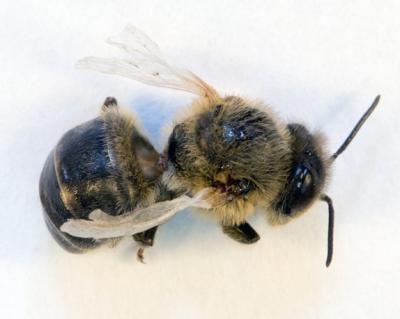Honeybees are a key pollinating insect, associated with around $40 billion in crops. In recent years, there were higher than normal colony losses (colony collapse disorder) has been a concern. Environmentalist have focused on neonicotinoid pesticides while science has believed it is a combination of weather and parasites.
The war on nature is not new, nor are new and emerging threats to insect pollinators.
Research has found that a bloodsucking parasite is a large part of the problem. It has transformed Deformed Wing Virus (DWV), one of the most common viruses infecting European honeybees, into one of the biggest threats facing UK honeybees. Although present in almost all colonies, high levels of deformed wing disease – characterized by developmental deformities, reduced foraging ability and longevity – are only common when
Varroa destructor, a tiny parasitic mite invading hives across the globe, is also present.

Classic symptoms of DWV include: stunted abdomen and incompletely developed wings. Credit: Professor David Evans, University of Warwick
Researchers at the University of Warwick have discovered how the disease is amplified in the presence of Varroa destructor. In colonies free from Varroa, DWV is present at very low levels and generally causes symptomless infections. However, the team found that when Varroa feeds on honeybee haemolymph ('blood'), specific virulent strains of the virus are transmitted and amplified, explaining why colonies infested with the mite suffer most severely.
The researchers also demonstrated that direct injection of a mixed DWV population in the absence of the mite, resulted in the same virulent strain being amplified – suggesting that this route of virus transmission bypasses the insect's anti-virus defense systems.
Professor David Evans, from the University of Warwick, who led the study explains, "We found that a harmful variant of the virus only multiplies rapidly if it is directly injected into honeybee haemolymph by Varroa. Once injected, the variant takes over. In mite-exposed bees, levels of this single virulent form can be 10,000 times higher than in the absence of Varroa."
"Although exposure to Varroa caused disruption to a number of genes involved in the bee's immune response, it is the route of transmission which has caused this severe strain of DWV to become widespread."
The introduction and global distribution of the mite has had a significant impact on the health and survival of honeybee colonies. The research, published today in the journal PLOS Pathogens could lead to informed breeding programs for Varroa and virus resistance.
Evans added, "Our results strongly suggest that DWV is widespread in UK honeybees – even where Varroa is absent. However, the identification of a single virulent form of the virus is an important step in developing strategies to boost honeybee health, to prevent colony losses and to safeguard this important pollinator."
The project is part of the Insect Pollinators Initiative, jointly funded by the Biotechnology and Biological Sciences Research Council (BBSRC), Defra, the Natural Environment Research Council (NERC), the Scottish Government and the Wellcome Trust under the auspices of the Living with Environmental Change (LWEC) partnership.
Professor Jackie Hunter, BBSRC Chief Executive commented: "This important study, part of the BBSRC-supported Insect Pollinators Initiative, provides important clues that could help to protect honeybee colonies. We rely on bees and other insects to pollinate food crops. We must sustain a healthy and diverse population of pollinating insects to ensure that we have enough food for the future."






Comments